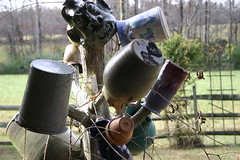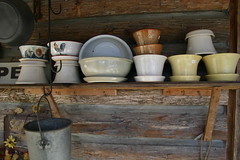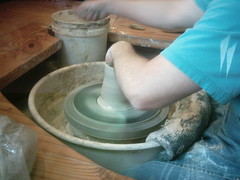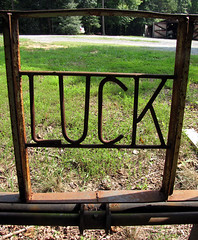Sid Luck
A Traditional Seagrove Potter
by Dr. Charles G. Zug III
Reprinted with permission from the Tar Heel Junior Historian, Fall 2009.
Tar Heel Junior Historian Association, NC Museum of History
 Nestled in the rolling farmland of southern Randolph County, Seagrove looks like any small, rural village. Along its two main streets sit two banks, a furniture factory, a Dollar General store, a couple of doctor’s offices, a gas station and convenience store, a produce market, and a hardware store. But far outnumbering these common businesses are potters’ shops and studios. Drive out of Seagrove in any direction—north or south, east or west—and more potters’ shops come into view, most of them modest, family-run operations.
Nestled in the rolling farmland of southern Randolph County, Seagrove looks like any small, rural village. Along its two main streets sit two banks, a furniture factory, a Dollar General store, a couple of doctor’s offices, a gas station and convenience store, a produce market, and a hardware store. But far outnumbering these common businesses are potters’ shops and studios. Drive out of Seagrove in any direction—north or south, east or west—and more potters’ shops come into view, most of them modest, family-run operations.
The Seagrove area, including nearby sections of Randolph, Moore, and Montgomery counties, boasts more than one hundred potteries. And Route 705, the main road that extends from Seagrove southwest into Moore County, has been officially named the “Pottery Highway” by the state. One can easily call Seagrove the pottery capital of North Carolina, or even of the nation. 
During the second half of the 1700s, potters born in Great Britain and Germany traveled south through the Shenandoah Valley of Virginia and settled in this region of North Carolina. Unlike in the Coastal Plain, clay was plentiful in the Piedmont, and so potters began producing a variety of pots for use in households and on farms. They dug up the local clay, shaped it on their wheels, and fired it with wood in homemade groundhog kilns. Most of the pottery forms were for food storage—like jugs, jars, churns, and milk crocks. But potters also made serving pieces such as pitchers, bowls, and baking dishes, as well as candlesticks, the chamber pots used in the days before indoor bathrooms, and even gravemarkers. Few stores existed, and people had little cash to spend anyway, so these sturdy, salt-glazed wares became essential tools for daily life.
Pottery provided everything from lighting to memorials to the dead. Potters learned simply by observing and imitating family members and neighbors. Numerous “clay clans” became well known—the Cole, Craven, Owen, Chrisco, Auman, and Teague families, to name a few.
 In general, the early pots were plain, useful, and inexpensive. However, some potters took the extra time to create bold, neatly trimmed forms to delight the hand and the eye. Their work proved remarkable in a world where artistic touches were very rare and unappreciated. Over time, more potters began to trade or sell what they had made. And then, starting in the 1920s, a different kind of pottery emerged. As factory-made tin cans and glass containers began to replace the old jugs, jars, and churns, potters needed to find something new to make and sell. So they turned to forms for modern homes, like plates, teapots, vases, urns, ashtrays, and birdhouses. With this explosion of new forms came brightly colored glazes—a whole rainbow of possibilities for decorating pots beyond the traditional browns and grays. Artistry became important, offering new options for the potters’ creativity.
In general, the early pots were plain, useful, and inexpensive. However, some potters took the extra time to create bold, neatly trimmed forms to delight the hand and the eye. Their work proved remarkable in a world where artistic touches were very rare and unappreciated. Over time, more potters began to trade or sell what they had made. And then, starting in the 1920s, a different kind of pottery emerged. As factory-made tin cans and glass containers began to replace the old jugs, jars, and churns, potters needed to find something new to make and sell. So they turned to forms for modern homes, like plates, teapots, vases, urns, ashtrays, and birdhouses. With this explosion of new forms came brightly colored glazes—a whole rainbow of possibilities for decorating pots beyond the traditional browns and grays. Artistry became important, offering new options for the potters’ creativity.
One well-known family that has been in the pottery business in the Seagrove area for over a century and a half is the Lucks. Today, sixty-four-year-old Sid Luck—himself a fifth-generation potter—operates Luck’s Ware with the help of his two sons, Jason and Matthew. Sid’s great-great-grandfather, William, got the family into the clay business in the mid-1800s by working with his son-in-law, Evan Cole, who ran one of the largest shops in the state. William’s son, Henry, worked in that shop, as well as for J. D. Craven, one of the most famous potters in Moore County. Sid’s grandfather, Bud, and father, James, continued the family tradition of producing salt-glazed stoneware, setting the stage for Sid’s career.
As with children growing up in many Seagrove families, Sid Luck’s earliest memories of pottery making came very early, from “my father, when I was six or so years old.” James Luck had little interest in the more recent art pottery. He preferred making the classic utilitarian forms, like churns. “He loved doing the large pieces. He didn’t care for turning a piece of clay that was under six pounds,” Sid said. When Sid was ten years old, he recalled, “That’s when I got interested in it, watching him. Plus, he pretty much said, ‘You need to learn how to do this.’ So he sort of, I guess, forced me into it, and I liked it.
His father’s informal teaching soon paid off. Just two years later, in 1957, well-known brother and sister potters Waymon Cole and Nell Cole Graves offered Sid Luck a job. He recalled, “I was good enough that they said, ‘Here, make these little ashtrays and hot butter dispensers and that sort of thing.’ So I started at the age of twelve; I was turning for them. And they paid me a little, probably paid me two dollars a day, or three or four. By the time I was twelve, thirteen years old, I could turn one hundred to two hundred ashtrays in one day.” In addition to his father and the Coles, Seagrove offered other legendary teachers, such as “Philmore Graves and Ben Owen and Melvin Owens, and all the older ones that were around here. We all sort of hung out together.”
With all this local training, Luck wanted to become a full-time potter. But pottery sales were very slow during the 1950s and 1960s, and Sid recognized that he “had to go another direction.” So he spent time in the Marine Corps, went to college, and then taught chemistry and science in school for eighteen years. But all that time, he kept making pots for the Coles. “Even after I got out of college and was teaching, they’d ask me if I’d come and turn pitchers for them. So I’d sometimes come down on the weekends and turn,” he said.
By the mid-1970s, Americans were planning to celebrate the nation’s bicentennial (or two hundredth anniversary), and reflecting on its history. This, in turn, made people more interested in antiques, folk art and all things “country,” and the handmade object. Interest in face jugs and other traditional forms of pottery exploded, and eager buyers began flocking to Seagrove. Luck saw many newcomers “moving into the Seagrove area doing pottery, which is what I had really loved doing.” And so he built his own shop. In 1990 he gave up teaching to become a full-time potter.
On the Web site for Luck’s Ware, Sid declares that “it has been my goal, all my life, to carry on as much of the old traditional work as I can.” And herein lies the focus for his creativity. He does make brightly colored tablewares and vases like other Seagrove potters, but his real love lies in the past. He said that he prefers to turn forms “like my family had made, just functional pieces. I like to make jugs; jugs still intrigue me. They’re a little more complicated.” Six years ago, Luck and his sons built an old-time groundhog kiln so they could fire their jars, milk crocks, churns, and pitchers in the traditional salt glaze. Few Seagrove potters make this “old” pottery anymore, perhaps viewing it as out of date. But buyers flock to the Luck pottery to buy Sid’s antique-style pieces. His graceful forms and rich, flowing salt glazes reflect the best work of his ancestors. And he and his sons have reenergized the old face jug—creating a variety of toothy, mustachioed, grinning characters.
As a traditional potter, Luck feels a responsibility to ensure that the next generation will carry on the family business. Like his father trained him, he has trained both of his sons. Jason is a patent lawyer in Charleston, South Carolina, but continues to throw pots, bringing them home to fire in the groundhog kiln. Matt operates a chicken farm and works in the pottery shop alongside his father. “He’s carrying on the family tradition in its purest form,” Luck explained, “because prior to me, all of my ancestors were potters and farmers. No lawyers and no teachers before me.” Times and tastes change, but the Lucks continue to build on their Seagrove heritage.
Dr. Charles G. Zug III is the author of Turners and Burners: The Folk Potters of North Carolina, published in 1986 by UNC Press. He is emeritus professor of English and folklore at the University of North Carolina at Chapel Hill and the former director of the North Carolina Pottery Center in Seagrove.
Additional Resources:
Seagrove Area Potters Association: http://www.discoverseagrove.com/
Seagrove Pottery Museum: http://www.seagrovepotterymuseum.org/.
North Carolina Pottery Center: #.
Luck's Ware: http://www.lucksware.com/home.html.
"The Potters of Seagrove." UNC TV. http://www.unctv.org/content/folkways/episodes/potters (accessed November 12, 2014).
Image Credits:
November 25, 2005. "Seagrove, King Pottery." Located at https://www.flickr.com/photos/jbweir/66999968/ . Accessed March 5, 2012.
November 25, 2005. "Seagrove." Located at https://www.flickr.com/photos/jbweir/66999969/. Accessed March 5, 2012.
August 8, 2009. "Seagrove 009." Located at https://www.flickr.com/photos/70212490@N00/3808858269/.
Nunnally, Robert. October 13. "North Carolina Potter North Carolina's Pottery Road features over 100 potters, making original pottery. Here a potter works on a pitcher, near Seagrove, NC." Located at https://www.flickr.com/photos/46183897@N00/3492636579/. Accessed March 5, 2012.
1 January 2009 | Zug, Charles G., III